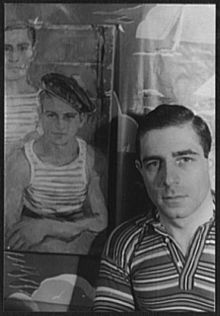그의 선구자적인 생각들은 현대 음악가들의 새로운 사상에 자극을 주었다. 하버드대학교에서 수학했으며
나중에는 파리의 저명한 작곡 교수인 나디아 블랑제에게 배웠다. 파리에서 그는 20세기초 프랑스의 작곡가들, 특히 다뤼스 미요, 아르튀르 오네게르, 프랑수아 풀랑크 등으로 대표되는 프랑스 6인조로부터 강한 영향을 받았다(→ 프랑스 6인조). 다양한 양식의 음악을 썼는데 그 가운데는 그레고리오 성가, 침례교 찬송가를 주제로 한 변주곡, 인상주의, 신고전주의가 포함되어 있으며 종종 전통 형식들을 현대적 기법과 결합시키기도 했다.
에리크 사티에게 가장 큰 영향을 받았으며 그러한 영향으로부터 표현의 명료성·단순성·유머가 만들어졌다.
그의 작품들 가운데는 오페라가 가장 잘 알려져 있다. 〈3막의 4인의 성자 Four Saints in Three Acts〉(1928)와 수잔 B. 앤서니의 생애를 그린 〈우리 모두의 어머니 The Mother of Us All〉(1947)는 모두 톰슨의 절친한 친구이자 미국의 전위작가인 거트루드 스타인의 대본에 의한 것들이다. 보다 후기의 오페라로는 〈바이런 경 Lord Byron〉(1968)이 있는데 이 작품에는 그가 사용했던 여러 가지 양식들이 결합·통합되어 있다.
그의 기악곡으로는 2곡의 교향곡, 여러 곡의 교향시, 첼로 협주곡(1950), 플루트 협주곡(1954)이 있다. 가곡, 합창곡, 실내악, 피아노 소품을 작곡했으며 페어 로렌츠의 탐험 기록영화 〈강 The River〉(1936)·〈The Plow that Broke the Plains〉(1937)와 로버트 플레허티의 〈루이지애나 이야기 Louisiana Story〉(이 영화음악으로 1949년 음악 부문 퓰리처상을 받음) 등의 영화를 위한 음악도 썼다.
그는 뉴욕 〈헤럴드 트리뷴〉의 음악 비평가로 활동했으며(1940~54) 통찰력 있고 예리한 비평문들을 모아 여러 차례 출판하기도 했다. 1966년에 자서전 〈버질 톰슨 Virgil Thomson〉이 출판되었다. 그밖의 저서로는 〈1940~54년 음악으로의 초대 Music Revisited, 1940~54〉(1967)·〈1910년 이후의 미국음악 American Music Since 1910〉(1971) 등이 있다.
Early years
Virgil Thomson was born in Kansas City, Missouri. As a child, he befriended Alice Smith, great-granddaughter of Joseph Smith, founder of the Latter-day Saint movement. After World War I, he entered Harvard University thanks to a loan from Dr. Fred M. Smith, the president of the Reorganized Church of Jesus Christ of Latter Day Saints, and father of Alice Smith. His tours of Europe with the Harvard Glee Club helped nurture his desire to return there. At Harvard, Thomson focused his studies on the piano work of Erik Satie. He studied in Paris on fellowship for a year, and after graduating, lived in Paris from 1925 until 1940. He eventually studied with Nadia Boulanger and became a fixture of "Paris in the twenties."
In 1925, in Paris, he cemented a relationship with painter Maurice Grosser (October 23, 1903 - December 22, 1986), who was to become his life partner and frequent collaborator. Later he and Grosser lived at the Hotel Chelsea, where he presided over a largely gay salon that attracted many of the leading figures in music and art and theater, including Leonard Bernstein, Tennessee Williams, and many others. He also encouraged many younger composers and literary figures such as Ned Rorem, Lou Harrison, John Cage, Frank O'Hara, and Paul Bowles. Grosser died in 1986, three years before Thomson.[10]
His most important friend from this period was Gertrude Stein, who was an artistic collaborator and mentor to him. Following the publication of his book, The State of Music, he established himself in New York City as a peer of Aaron Copland, and was also a music critic for the New York Herald-Tribune from 1940 to 1954.[11]
His writings on music, and his reviews of performances in particular, are noted for their wit and their independent judgments.[who?] His definition of music was famously "that which musicians do,"[12] and his views on music are radical in their insistence on reducing the rarefied aesthetics of music to market activity.
He even went so far as to claim that the style a piece was written in could be most effectively understood as a consequence of its income source.[13]
Later years
In 1969, Thompson composed Metropolitan Museum Fanfare: Portrait Of An American Artist to accompany the Museum's Centennial exhibition "New York Painting And Sculpture: 1940–1970."[14][15]
Thomson became a sort of mentor and father figure to a new generation of American tonal composers
such as Ned Rorem, Paul Bowles and Leonard Bernstein, a circle united as much by their shared homosexuality as by their similar compositional sensibilities.[16] Women composers were not part of that circle,
and some have suggested that, as a critic, he pointedly ignored their works, or adopted a patronizing tone.[17]
Thomson's score for The River was used in the 1983 ABC made-for-television movie The Day After. Thomson's personal papers are in a repository at the Archival Papers in the Music Library of Yale University and also additional effects regarding Thomson are included in the Ian Hornak repository at the Smithsonian Institution's Archives of American Art in Washington D.C.[citation needed]
Awards and honors
Thomson was a recipient of Yale University's Sanford Medal.[18] In 1988, he was awarded the National Medal of Arts.[19] He was a National Patron of Delta Omicron, an international professional music fraternity.[20]
Death
Virgil Thomson died on September 30, 1989, in his suite at the Hotel Chelsea in Manhattan, aged 92.
'♣ 음악 감상실 ♣ > [1881년 이후]' 카테고리의 다른 글
| [오스트리아] Joseph Marx (0) | 2018.08.23 |
|---|---|
| [오스트리아 태생 미국 음악가]Ernst Krenek[에른스트 그레네크] (0) | 2017.10.04 |
| [네델란드 여성음악가]Henriëtte Bosmans (0) | 2017.07.23 |
| [이탈리아]Alfredo Catalani[알프레도 카탈라니] (0) | 2017.06.06 |
| [이탈리아]Gian Francesco Malipiero (0) | 2017.06.06 |

